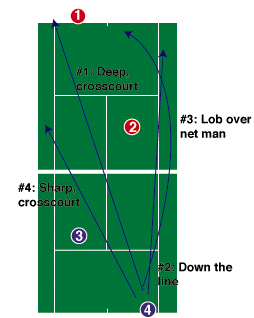By Mike Whittington,
TennisONE Contributing Editor
Good receivers have consistent returns but are also able to add variety to keep their opponents guessing. A good receiver should have at least four different return options.

With the power serves in today's game, it's important to add the lob return to your arsenal. When the server has made you stretch or thrown you off balance, the defensive lob is a much safer shot than going for a drive return. An offensive return over the server's partner will allow you to take control of the net as well as keep an aggressive team from dominating with forceful net play. I personally feel the lob is the most underutilized return and I stress it with students at all levels.
Another good way to throw off your opponents is to go down the line. This is great as an occasional change up against an aggressive team. Once you attempt this shot (even if you're not successful), your opponents will be less likely to leave their alley open. I encourage my players to try this shot when they are up by a couple of points in a game and they get a wide serve.
The fourth return is the one the pros make look so easy--the low, sharp, crosscourt angle. You're going for a small piece of the pie but what a payoff if you make it! It forces the server way off the court and forces him to hit up to your net partner. You can hit it with the rolling topspin or as a chip shot. Get consistent with this shot and you will want to return more than serve!
Every team presents different returning challenges. By
mastering these four returns, you should be ready to master any challenge
they throw your way.
Send email to the author
We encourage you to email your comments (pro, con, appreciative, whatever)
directly to the author. To send email to Mike Whittington, click
here.
Back to TennisONE Home Page
What's New | Tennis
Lessons | Tennis in Your Area
Tennis Fitness | Tennis
Products | Sponsors/Advertisers/Consultants
TennisONE© is a trademark of TennisONE© and SportsWeb ONE©.
Copyright© 1995. All rights reserved.
<% ns_puts [nsv_get mkm_includes mkm_oldContentFooter_inc] %>